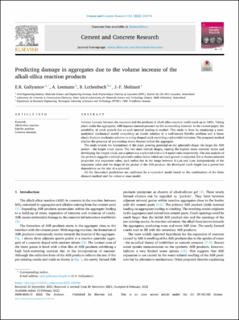| dc.contributor.author | Gallyamov, E.R. | |
| dc.contributor.author | Leemann, A. | |
| dc.contributor.author | Lothenbach, Barbara | |
| dc.contributor.author | Molinari, J.-F. | |
| dc.date.accessioned | 2023-03-31T07:27:56Z | |
| dc.date.available | 2023-03-31T07:27:56Z | |
| dc.date.created | 2022-04-28T14:13:37Z | |
| dc.date.issued | 2022 | |
| dc.identifier.citation | Cement and Concrete Research. 2022, 154 . | en_US |
| dc.identifier.issn | 0008-8846 | |
| dc.identifier.uri | https://hdl.handle.net/11250/3061292 | |
| dc.description.abstract | Volume increase between the reactants and the products of alkali-silica reaction could reach up to 100%. Taking place inside the aggregates, ASR imposes internal pressure on the surrounding material. In the current paper, the possibility of crack growth due to such internal loading is studied. This study is done by employing a semi-analytical mechanical model comprising an elastic solution to a well-known Eshelby problem and a linear elastic fracture mechanics solution to a ring-shaped crack encircling a spheroidal inclusion. The proposed method implies the presence of pre-existing micro-fissures within the aggregate.
The study reveals the dependence of the crack growing potential on the spheroid's shape: the larger the ASR pocket - the longer crack opens. The two most critical shapes, causing the highest stress intensity factor and developing the longest crack, are a sphere and a spheroid with a 1/4 aspect ratio respectively. The size analysis of the problem suggests a critical spheroid's radius below which no crack growth is expected. For a chosen material properties and expansion value, such radius lies in the range between 0.1 μm and 1 μm. Independently of the expansion value and the shape of the pocket of the ASR product, the developed crack length has a power-law dependence on the size of a spheroid. | en_US |
| dc.language.iso | eng | en_US |
| dc.publisher | Elsevier | en_US |
| dc.rights | Attribution-NonCommercial-NoDerivatives 4.0 Internasjonal | * |
| dc.rights.uri | http://creativecommons.org/licenses/by-nc-nd/4.0/deed.no | * |
| dc.title | Predicting damage in aggregates due to the volume increase of the alkali-silica reaction products | en_US |
| dc.title.alternative | Predicting damage in aggregates due to the volume increase of the alkali-silica reaction products | en_US |
| dc.type | Peer reviewed | en_US |
| dc.type | Journal article | en_US |
| dc.description.version | publishedVersion | en_US |
| dc.source.pagenumber | 9 | en_US |
| dc.source.volume | 154 | en_US |
| dc.source.journal | Cement and Concrete Research | en_US |
| dc.identifier.doi | 10.1016/j.cemconres.2022.106744 | |
| dc.identifier.cristin | 2019835 | |
| cristin.ispublished | true | |
| cristin.fulltext | original | |
| cristin.qualitycode | 2 | |

